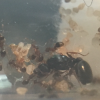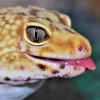- Formiculture.com
- Forums
- Gallery
- Members
- Member Map
- Chat

Prenolepis Imparis colony life
Started By
Amazant
, Mar 20 2020 9:19 PM
8 replies to this topic
#1
 Offline
-
Posted March 20 2020 - 9:19 PM
Offline
-
Posted March 20 2020 - 9:19 PM
I fought two winter ants yesterday on March 20th during the afternoon while scattered showers were happening and it was around 71 degrees and the humidity was high. One queen had already shed its wings while the second queen had its wings and shed them later.
So the question is do winter ant colonies last more than a year or two without having queens introduced every year. Do they lay eggs after capture in a 71 degree room or do they need to be cooler. Will a colony with two queens work or will that fail. What ways can you make a winter ant lay eggs after their first summer.
Thanks for any feedback
So the question is do winter ant colonies last more than a year or two without having queens introduced every year. Do they lay eggs after capture in a 71 degree room or do they need to be cooler. Will a colony with two queens work or will that fail. What ways can you make a winter ant lay eggs after their first summer.
Thanks for any feedback
Colonies: Formica pallidefulva, Lasius neoniger, Camponotus decipiens, Camponotus sp, Camponotus Vicinus, Crematogaster Sp
#2
 Online
-
Posted March 21 2020 - 6:16 AM
Online
-
Posted March 21 2020 - 6:16 AM
I would assume so. Hardly anyone has documented it, though. You’d be the first!
Edited by AntsDakota, March 21 2020 - 6:21 AM.
"God made..... all the creatures that move along the ground according to their kinds (including ants). And God saw that it was good. Genesis 1:25 NIV version
Keeping:
Formica cf. pallidefulva, cf. incerta, cf. argentea
Formica cf. aserva, cf. subintegra
Myrmica sp.
Lasius neoniger, brevicornis
#3
 Offline
-
Posted March 21 2020 - 6:29 AM
Offline
-
Posted March 21 2020 - 6:29 AM
Not true. Others have gotten colonies over two years. I believe @Reevak did.
- Amazant likes this
Hi there! I went on a 6 month or so hiatus, in part due, and in part cause of the death of my colonies.
However, I went back to the Sierras, and restarted my collection, which is now as follows:
Aphaenogaster uinta, Camponotus vicinus, Camponotus modoc, Formica cf. aserva, Formica cf. micropthalma, Formica cf. manni, Formica subpolita, Formica cf. subaenescens, Lasius americanus, Manica invidia, Pogonomyrmex salinus, Pogonomyrmex sp. 1, Solenopsis validiuscula, & Solenopsis sp. 3 (new Sierra variant).
#4
 Online
-
Posted March 21 2020 - 6:32 AM
Online
-
Posted March 21 2020 - 6:32 AM
That’s what I thought. Even Antwiki claims they can get to several thousand workers, and have you any idea how long it would take a Prenolepis colony to get that big........
- Amazant likes this
"God made..... all the creatures that move along the ground according to their kinds (including ants). And God saw that it was good. Genesis 1:25 NIV version
Keeping:
Formica cf. pallidefulva, cf. incerta, cf. argentea
Formica cf. aserva, cf. subintegra
Myrmica sp.
Lasius neoniger, brevicornis
#5
 Offline
-
Posted March 21 2020 - 8:29 AM
Offline
-
Posted March 21 2020 - 8:29 AM
I'm not sure if this is unusual or not, but I've found trails of prenolepis imparis hundreds strong along a tree branch in summer. I am 100% sure the were p. imparis too.
- RushmoreAnts likes this
Plants r cool
#6
 Offline
-
Posted March 30 2020 - 4:19 PM
Offline
-
Posted March 30 2020 - 4:19 PM
I'm not sure if this is unusual or not, but I've found trails of prenolepis imparis hundreds strong along a tree branch in summer. I am 100% sure the were p. imparis too.
It's not unusual at all. Just set out banana slices near a nest and they're sure to come by the tens, at least. Whether or not large colonies can exist isn't the question(they do outside of captivity), what is strange is that there's such a huge difference between the success of wild vs. captive colonies. You can't help but wonder if there's something we haven't figured about how to keep them yet. Maybe it's the bananas ![]()
- ANTdrew likes this
I accidentally froze all my ants
#7
 Online
-
Posted March 30 2020 - 4:40 PM
Online
-
Posted March 30 2020 - 4:40 PM
Even AntWiki claims their colonies get to several thousand workers (and call it a small colony, lol).
"God made..... all the creatures that move along the ground according to their kinds (including ants). And God saw that it was good. Genesis 1:25 NIV version
Keeping:
Formica cf. pallidefulva, cf. incerta, cf. argentea
Formica cf. aserva, cf. subintegra
Myrmica sp.
Lasius neoniger, brevicornis
#8
 Offline
-
Posted March 31 2020 - 6:42 AM
Offline
-
Posted March 31 2020 - 6:42 AM
Well compared to Camponotus, Formica and Lasius.
Hi there! I went on a 6 month or so hiatus, in part due, and in part cause of the death of my colonies.
However, I went back to the Sierras, and restarted my collection, which is now as follows:
Aphaenogaster uinta, Camponotus vicinus, Camponotus modoc, Formica cf. aserva, Formica cf. micropthalma, Formica cf. manni, Formica subpolita, Formica cf. subaenescens, Lasius americanus, Manica invidia, Pogonomyrmex salinus, Pogonomyrmex sp. 1, Solenopsis validiuscula, & Solenopsis sp. 3 (new Sierra variant).
#9
 Online
-
Posted March 31 2020 - 8:21 AM
Online
-
Posted March 31 2020 - 8:21 AM
Some Formica and Camponotus only get to a few hundred workers, and I don’t know if Lasius neoniger and related species grow larger than a few thousand.
"God made..... all the creatures that move along the ground according to their kinds (including ants). And God saw that it was good. Genesis 1:25 NIV version
Keeping:
Formica cf. pallidefulva, cf. incerta, cf. argentea
Formica cf. aserva, cf. subintegra
Myrmica sp.
Lasius neoniger, brevicornis
0 user(s) are reading this topic
0 members, 0 guests, 0 anonymous users


















